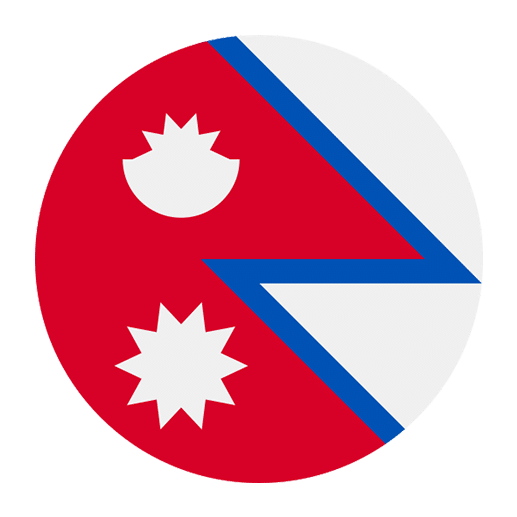Punctuation marks serve as crucial tools in written language, helping to clarify meaning, indicate pauses, and separate ideas. While many learners of Nepali may focus initially on vocabulary and grammar, understanding punctuation is equally important for mastering written communication. This article explores the various punctuation marks used in Nepali, their functions, and how they compare to those in English.
Period (पूर्णविराम / Purnavirām)
The period in Nepali, known as पूर्णविराम (Purnavirām), functions much like the period in English. It is used to mark the end of a declarative sentence. In Nepali script (Devanagari), the period is represented by a vertical line (।) rather than a dot.
Example:
नेपाली भाषा मिठो छ।
(Nepali bhāṣā miṭho cha.)
Translation: Nepali language is sweet.
Comma (अल्पविराम / Alpavirām)
The comma, referred to as अल्पविराम (Alpavirām) in Nepali, is used to separate elements within a sentence, such as items in a list or clauses. The usage is quite similar to that in English, though Nepali often uses commas more sparingly.
Example:
मैले स्याउ, केरा, र सन्तरा किनें।
(Maile syāu, kerā, ra santarā kinēṃ.)
Translation: I bought apples, bananas, and oranges.
Question Mark (प्रश्नवाचक चिन्ह / Praśnavācak Chinha)
The question mark in Nepali, known as प्रश्नवाचक चिन्ह (Praśnavācak Chinha), is used at the end of a question. It looks identical to the question mark in English and serves the same function.
Example:
तिमीले खाना खायौ?
(Timīle khānā khāyau?)
Translation: Did you eat?
Exclamation Mark (विस्मयादिबोधक चिन्ह / Vismayādibodhak Chinha)
The exclamation mark, or विस्मयादिबोधक चिन्ह (Vismayādibodhak Chinha), is used to express strong emotions, such as surprise, joy, or anger. Its appearance and function are the same as in English.
Example:
कति सुन्दर!
(Kati sundar!)
Translation: How beautiful!
Quotation Marks (उद्धरण चिन्ह / Uddharaṇ Chinha)
Quotation marks, known as उद्धरण चिन्ह (Uddharaṇ Chinha) in Nepali, are used to enclose direct speech or quotations. In Nepali, quotation marks are usually written as ” ” (double quotes) just like in English. However, single quotes (‘ ’) can also be used.
Example:
उसले भन्यो, “म आउँदैछु।”
(Usle bhanyo, “Ma āumdai chu.”)
Translation: He said, “I am coming.”
Colon (द्वैद्विराम / Dvaidvirām)
The colon, referred to as द्वैद्विराम (Dvaidvirām) in Nepali, is used to introduce a list, explanation, or a quotation. Its usage is similar to that in English.
Example:
म सँग यी चीजहरू छन्: किताब, कलम, र कापी।
(Ma saṅga yī cījharu chaṇ: kitāb, kalam, ra kāpī.)
Translation: I have these things: a book, a pen, and a notebook.
Semicolon (अर्धविराम / Ardhavirām)
The semicolon, or अर्धविराम (Ardhavirām), is used to link closely related independent clauses or to separate items in a complex list. Its usage is similar to that in English, though it is less commonly used in Nepali.
Example:
मलाई यात्रा गर्न मन पर्छ; यो मलाई स्वतन्त्रता दिन्छ।
(Mālai yātrā garn man parcha; yo mālai svatantratā dincha.)
Translation: I like to travel; it gives me freedom.
Apostrophe (अल्पविराम / Alpavirām)
In Nepali, the apostrophe is not commonly used as it is in English for contractions or possessives. Instead, context and grammar structure usually make the meaning clear. However, when transliterating English names or words, an apostrophe might be used.
Example:
रामको किताब
(Rāmko kitāb)
Translation: Ram’s book.
Parentheses (कोष्ठक / Koṣṭhak)
Parentheses, known as कोष्ठक (Koṣṭhak) in Nepali, are used to enclose additional information or asides that are supplementary to the main text. Their usage is similar to that in English.
Example:
नेपाली (नेपालको सरकारी भाषा) धेरै मीठो छ।
(Nepālī (Nepālko sarakārī bhāṣā) dherai mīṭho cha.)
Translation: Nepali (the official language of Nepal) is very sweet.
Dash (ड्यास / Ḍyās)
The dash, or ड्यास (Ḍyās) in Nepali, can be used to create a strong break in a sentence, set off parenthetical material, or indicate ranges. Its usage is quite similar to that in English.
Example:
यो कुरा – मलाई थाहा थियो – सही हो।
(Yo kurā – mālai thāhā thiyo – sahī ho.)
Translation: This thing – I knew – is correct.
Ellipsis (त्रिपुटी / Tripuṭī)
The ellipsis, known as त्रिपुटी (Tripuṭī) in Nepali, is used to indicate the omission of words or to create a pause for effect. It is represented by three dots (…).
Example:
मलाई लाग्छ… त्यो ठीक छ।
(Mālai lāgcha… tyo ṭhīk cha.)
Translation: I think… that’s okay.
Usage in Digital Communication
In the age of digital communication, Nepali punctuation has adapted to fit the norms of texting, social media, and other online platforms. Emojis and shorthand notations are often used in place of traditional punctuation to convey tone and emotion.
Example:
तिमी कस्तो छौ? 😊
(Timī kasto chau? 😊)
Translation: How are you? 😊
Punctuation in Formal Writing
In formal writing, such as academic papers, official documents, and literature, the correct use of punctuation is crucial for clarity and professionalism. Unlike informal digital communication, formal writing adheres strictly to the rules of punctuation.
Example:
नेपाली साहित्यमा पूर्णविरामको प्रयोग अनिवार्य छ।
(Nepālī sāhityamā purnavirāmakā prayog anivārya cha.)
Translation: The use of the period is mandatory in Nepali literature.
Punctuation in Poetry
In Nepali poetry, punctuation can be used creatively to enhance the rhythm, flow, and emotional impact of the verses. Poets often manipulate punctuation to break conventional norms and create unique expressions.
Example:
सपनाहरू – हर रात, हर क्षण,
म प्यार गर्छु – तिम्रो हाँसोमा।
(Sapanāharū – har rāt, har kṣaṇ,
ma pyār garchu – timro hāṃsomā.)
Translation: Dreams – every night, every moment,
I love – in your smile.
Comparison with English Punctuation
While Nepali punctuation shares many similarities with English, there are some key differences:
1. The use of the vertical line (।) as a period is unique to Nepali and other languages using the Devanagari script.
2. Nepali uses fewer commas compared to English, often relying on context and grammatical structure to convey meaning.
3. The semicolon is less frequently used in Nepali.
4. Punctuation in Nepali is more flexible in informal settings, especially in digital communication, whereas English tends to maintain more rigid punctuation rules even in informal contexts.
Common Mistakes and Tips
Learning the correct use of punctuation in Nepali can be challenging for English speakers due to the differences in script and usage norms. Here are some common mistakes and tips to avoid them:
Common Mistakes:
1. Overusing commas: English speakers may be tempted to insert commas more frequently than necessary.
2. Misplacing the period: Remember that the period in Nepali is a vertical line (।), not a dot.
3. Ignoring formal punctuation rules: While informal writing can be flexible, formal writing should adhere to strict punctuation rules.
Tips:
1. Practice reading Nepali texts: Familiarize yourself with the natural flow and punctuation of Nepali by reading books, newspapers, and articles.
2. Write and revise: Practice writing in Nepali and revise your work to ensure correct punctuation.
3. Seek feedback: Ask native speakers or teachers to review your writing and provide feedback on your punctuation usage.
Conclusion
Understanding and correctly using punctuation in Nepali is essential for clear and effective written communication. While there are similarities to English punctuation, there are also unique aspects that learners need to master. By paying attention to these details and practicing regularly, English speakers can improve their Nepali writing skills and communicate more effectively in both formal and informal settings. Whether you’re writing a formal document, a poem, or a social media post, mastering Nepali punctuation will enhance your ability to express yourself clearly and accurately.

